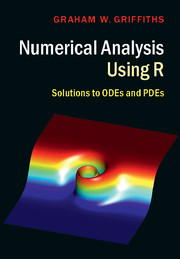Book contents
- Frontmatter
- Dedication
- Contents
- Preface
- 1 ODE Integration Methods
- 2 Stability Analysis of ODE Integrators
- 3 Numerical Solution of PDEs
- 4 PDE Stability Analysis
- 5 Dissipation and Dispersion
- 6 High-Resolution Schemes
- 7 Meshless Methods
- 8 Conservation Laws
- 9 Case Study: Analysis of Golf Ball Flight
- 10 Case Study: Taylor–Sedov Blast Wave
- 11 CaseStudy: The Carbon Cycle
- Appendix: A Mathematical Aide-Mémoire
- Index
- Plate section
- References
7 - Meshless Methods
Published online by Cambridge University Press: 05 May 2016
- Frontmatter
- Dedication
- Contents
- Preface
- 1 ODE Integration Methods
- 2 Stability Analysis of ODE Integrators
- 3 Numerical Solution of PDEs
- 4 PDE Stability Analysis
- 5 Dissipation and Dispersion
- 6 High-Resolution Schemes
- 7 Meshless Methods
- 8 Conservation Laws
- 9 Case Study: Analysis of Golf Ball Flight
- 10 Case Study: Taylor–Sedov Blast Wave
- 11 CaseStudy: The Carbon Cycle
- Appendix: A Mathematical Aide-Mémoire
- Index
- Plate section
- References
Summary
INTRODUCTION
In this chapter we provide an introduction to meshless methods. It will, of necessity, be brief as this is a very wide subject that is still developing and that has many application areas. Here the main focus of our discussion will be interpolation of scattered data and the numerical solution of partial differential equations (PDEs) using radial basis functions (RBFs). A basis set is a set of elements that are used to describe a particular system of interest. The elements referred to here are a set of linearly independent basis functions (with radial symmetry or that are radially invariant) that apply to a function space. The field of radial basis functions (RBFs) was initiated by Hardy [Har-71, Har-90], who proposed the now widely used multiquadratic RBF for use in a multidimensional scattered interpolation method.
Every continuous function can generally be represented as a linear combination of basis functions (also called blending functions). In other words, if we wish to describe a function mathematically over a continuous domain, we can form a representation from a weighted sum of appropriate basis functions. For example, a representation of a periodic function f (t) can be formed using a weighted sum of sines and cosines. This is called a Fourier series, and the set of Fourier series functions has {sin(nωt) ∪ cos(nωt) : n ∈ ℤ} as its basis, where ω is the fundamental frequency of the process represented by f (t) and nω the nth harmonic. This definition of the basis is applicable because each Fourier series can be formed from a linear combination of these basis functions.
For problems having complex solutions it may be advantageous to restrict the influence of distant RBFs. Consequently, the class of compactly supported RBFs has been developed whereby their value is truncated at a certain distance from the associated collocation point (see Section 7.2.2). As problems increase in size, the computation can be made more efficient by employing local RBF methods such that the solution at a particular collocation point, say, xi, is approximated by a weighted set of local RBFs which are close neighbors, rather than by all the RBFs within the solution domain (see Section 7.5).
Information
- Type
- Chapter
- Information
- Numerical Analysis Using RSolutions to ODEs and PDEs, pp. 380 - 456Publisher: Cambridge University PressPrint publication year: 2016
